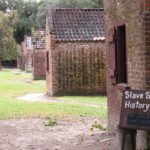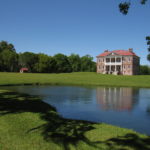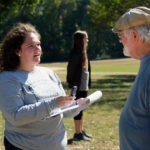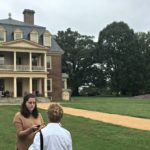A transition is taking place in the narratives of Southern plantation museums in the United States. The romanticized “Gone With the Wind” kinds of stories are slowly fading away to be replaced, in some instances, with histories about slavery and human hardship.
While some sites worry that telling unpleasant truths about America’s history could have negative consequences, early research conducted by UMW as part of a national grant favors a different conclusion.
“We’ve heard from several plantations that there is the fear that if they start talking about uncomfortable, controversial topics, then people won’t come,” said Stephen Hanna, professor of geography at the University of Mary Washington. “One thing our research suggests is that people aren’t surprised to hear about slavery and that there could be more discussion about slavery.”
For the past three years, Hanna and seven UMW students – four of whom are now alumni – have been conducting fieldwork at plantation museums in the American South as part of a $445,423 grant from the National Science Foundation. Partnering with faculty and students at five other universities , the UMW team has helped to document 170 tours and conduct 2,500 surveys or interviews of plantation visitors, tour guides and museum staff. The work has taken place at 17 sites in Louisiana, South Carolina and Virginia.
The team wrapped up its research in October with a final visit to the 19th-century Meadow Farm Museum in Henrico County, Virginia. Over the next year, they will transcribe, code and analyze the qualitative data they collected before publishing the results. For the students involved in the project, titled “Transformation of Racialized American Southern Heritage Landscape,” the hands-on research and fieldwork offers a unique opportunity.
“Most people are surprised we’re undergrads working on this project,” said senior Christine MacKrell, a geography and political science major who has been working with Hanna for two years. “We’re working alongside multiple universities across the nation with highly regarded professors and Ph.D. and grad students. It’s rare for undergrads to get this kind of fieldwork, research and writing experience.”
While final research results will not be published until next year, Hanna and his students have published or presented preliminary findings in journals and at national and regional conferences. Their full immersion in the research process builds the team’s passion and enthusiasm for what they’ve learned.
“There’s a trend toward being more authentic in the stories you’re telling,” said senior Sarah Rogers, a geography and historic preservation major who has been involved with the project for one year. “People come to these plantations because they want to learn about history, and it’s the museum’s responsibility to share true, accurate and representative stories and information.”
Learning about our nation’s history shapes our understanding of what it means to be an American, Hanna said, and helps us deal with the racial issues facing our country today.
“We want to be able to talk about how we remember our past and how it informs our understanding of present issues,” he said. “It’s important that these museums present inclusive stories of our past rather than excluding this painful chapter of American history.”







